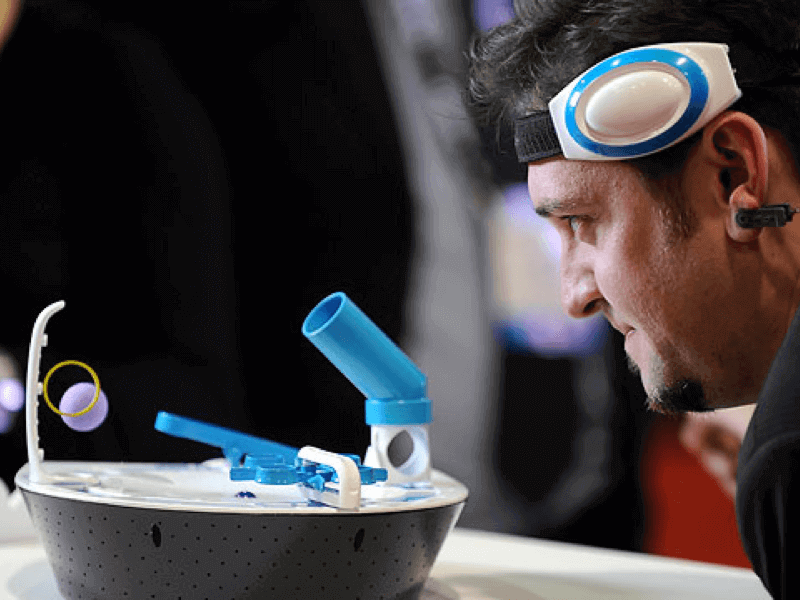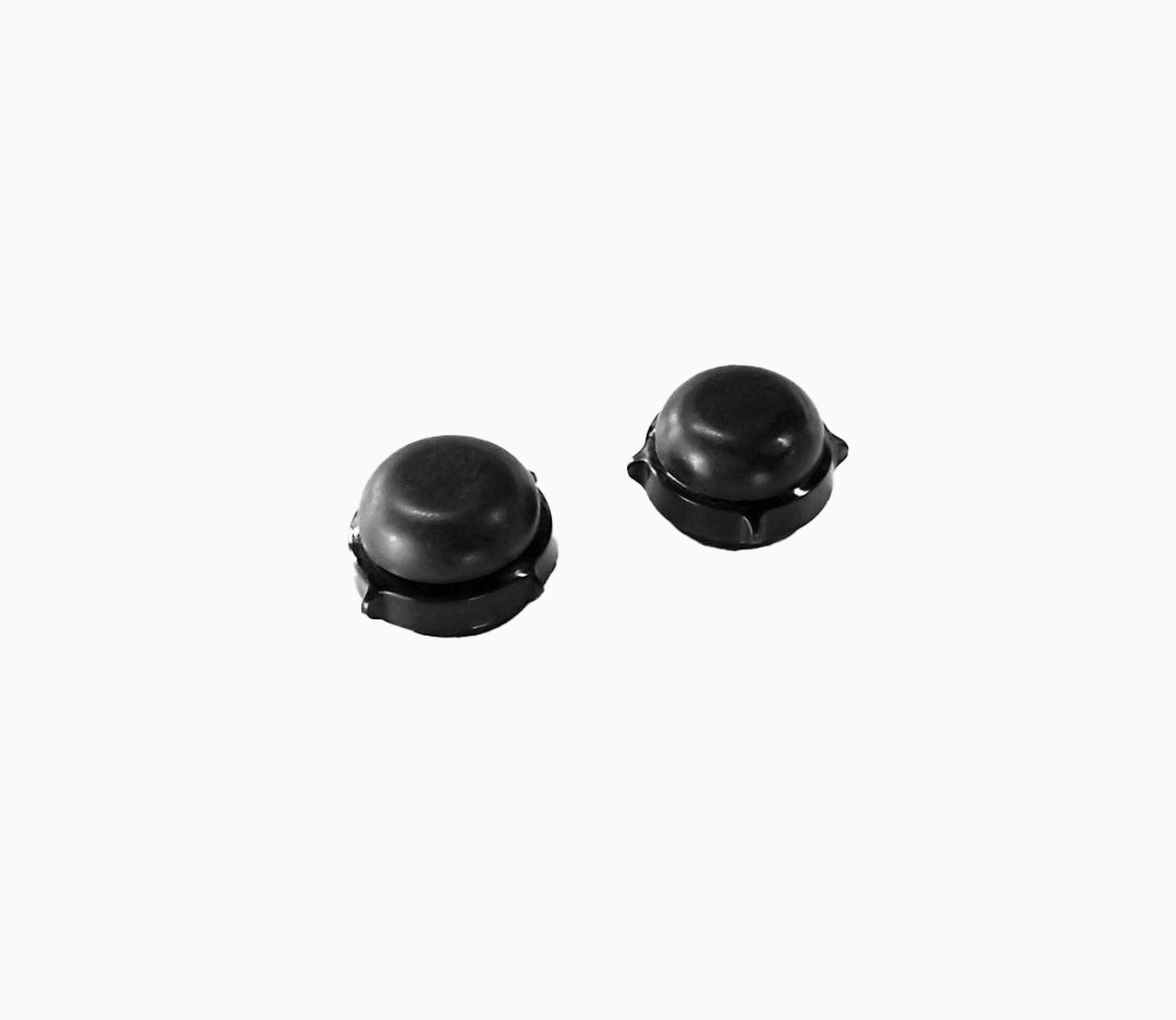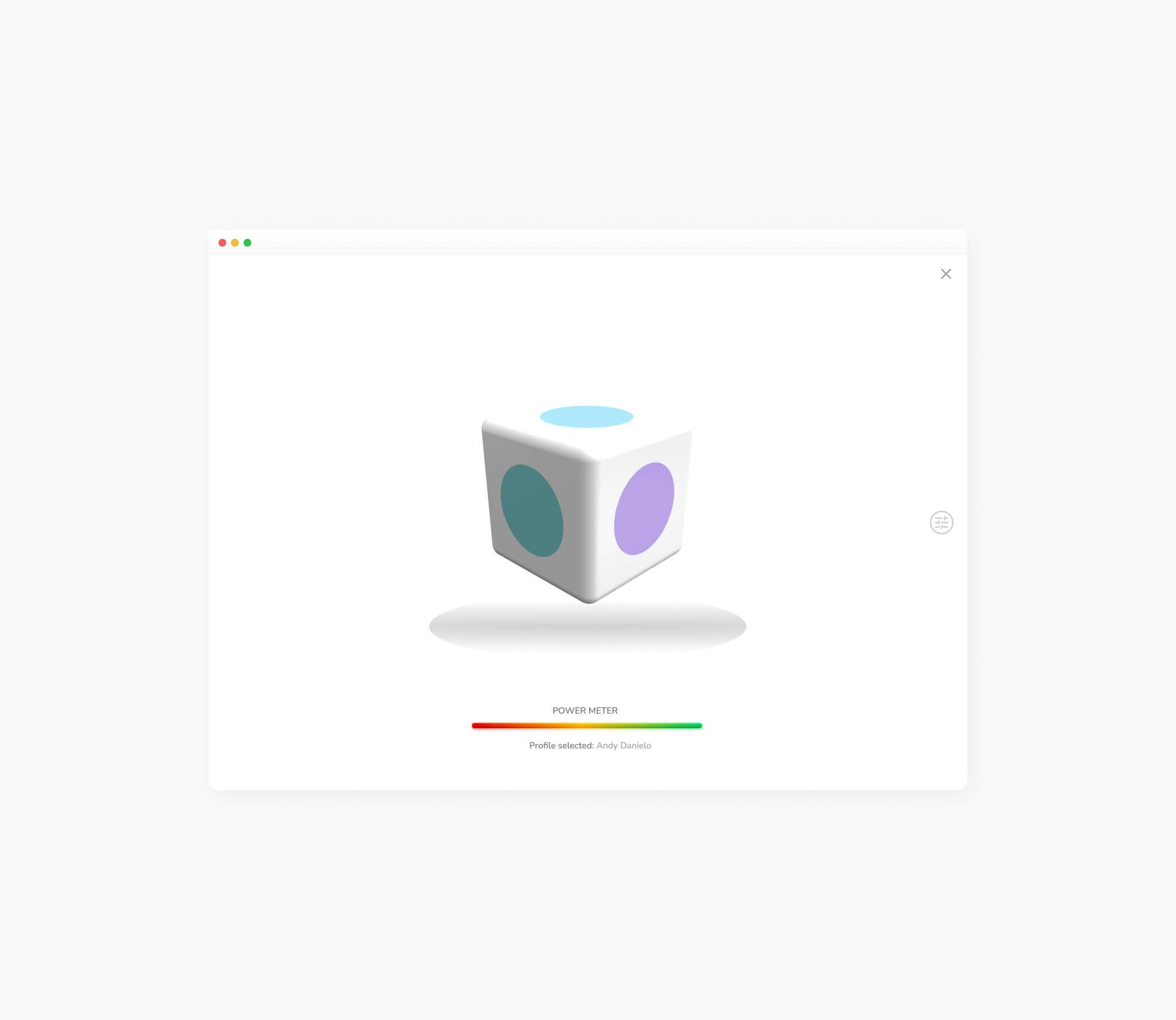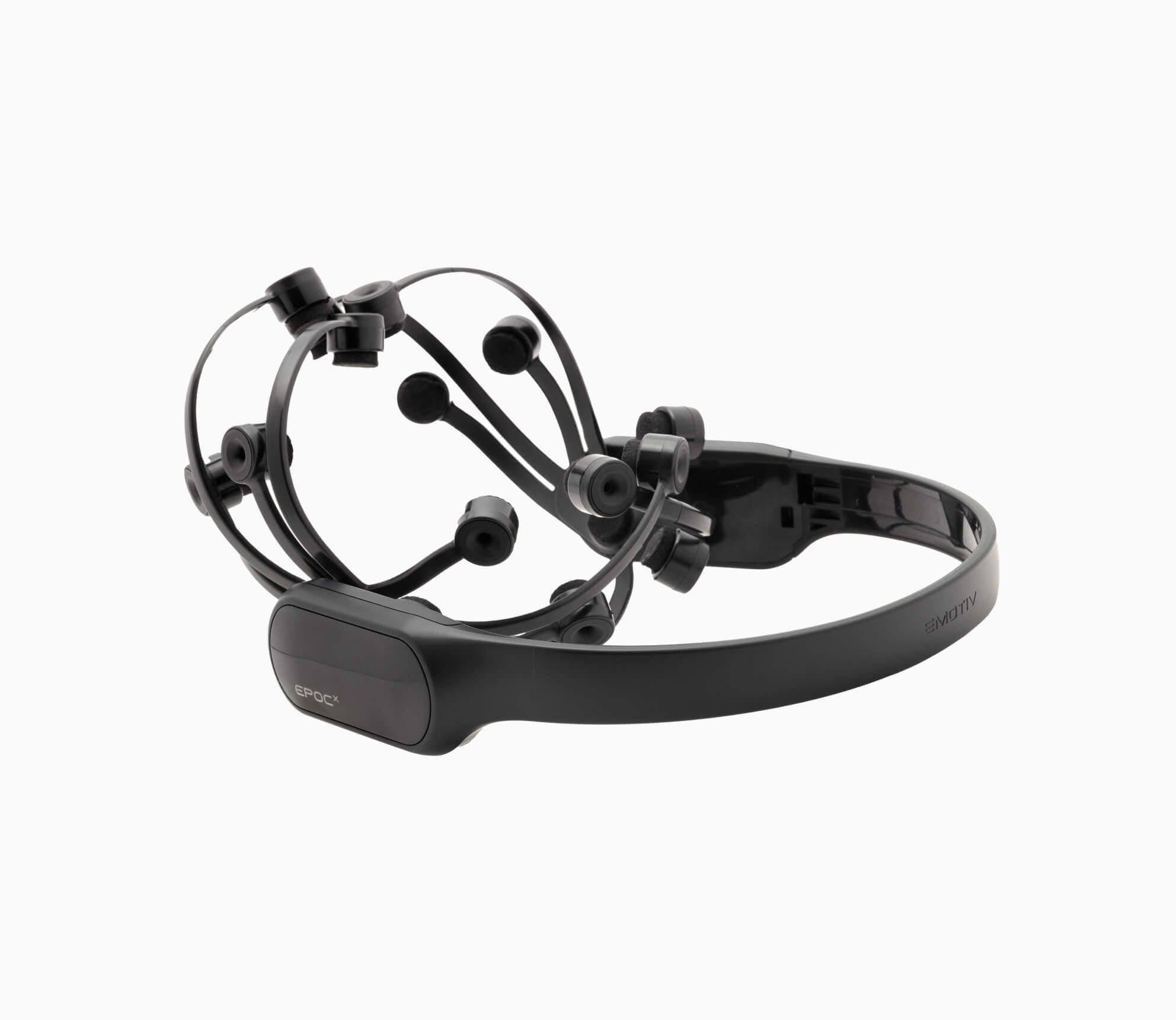***Disclaimer - EMOTIV products are intended to be used for research applications and personal use only. Our products are not sold as Medical Devices as defined in EU directive 93/42/EEC. Our products are not designed or intended to be used for diagnosis or treatment of disease.
Brain Computer Interface Definition
What does BCI mean? A BCI (brain-computer interface) is technology that sends and receives signals between the brain and an external device. Brain-computer interfaces are also called brain-machine interfaces. BCIs collect and interpret brain signals, and then transmit them to a connected machine that outputs commands associated with the brain signals received.
A simplified BCI definition might describe the technology as communication link between the brain and an external device. BCI can be passive or active. A passive BCI merely interprets brain signals to give insight into the cognitive state of an individual. For example, it may be used to detect a user’s emotional state. An active BCI requires users to actively modulate their brain signals to interact with an external device. For example, a user may imagine moving their arm causing a robotic arm to move in the same way.
Signal Acquisition
ECoG, LFP, EEG,SU, Others
Signal Processing
Autoregressive, Fourier Transform,
Common Spatial Filters, Laplacian Filter,
Wavelets, Others
Effector Devices
-
Spellers
- Cursors
- Wheelchairs
- Robotic Arms
How Does a BCI Work?
Our brains are filled with cells called neurons. Every time we think, move, feel or remember something, our neurons are at work. That work is carried out by biochemical and electric signals. Scientists can detect those signals and interpret what they mean by using electroencephalography (EEG) technology. EEG can read signals from the human brain and send them to amplifiers. The amplified signals are then interpreted by a BCI computer program, which uses the signals to control a device.
What is a BCI?
A BCI can also be called a brain-machine interface, a neural-control interface, a mind-machine interface or a direct neural interface. A BCI allows for direct communication between the brain and an external device, often to control its activity. BCIs read signals from the brain and use machine learning algorithms to translate the signals into an external action.
BCI Solutions and Technology TED Talk
BCI and EEG
EEG-based BCI are characterized by the technique of using non-invasive EEG electrodes to measure brain activity and translate the recorded brain signals into commands.
BCIs detect changes in brain activity measured through an EEG. BCI technologies then relay these signals to machine learning algorithms. The machine learning algorithms have been trained to pick up on EEG brain activity associated with certain emotions, actions and expressions. When the algorithms identify matching EEG brain activity, the BCI can transmit external commands to control a device (such as a computer cursor, robotic arm or wheelchair). The devices have been programmed to interpret and carry out these commands, whether controlling a physical object or a digital interface. A subject wearing an EEG device can think “move left” and the cursor moves to the left — that’s an example of an external action conducted on a digital interface. A subject using EEG-based BCI that’s connected to a robotic arm can think “wave” and the robotic arm will wave.
What is a BCI Used For?
Brain-computer Interface Research
BCI research (also called brain-machine interface research) represents a rapidly growing field. Academic researchers have studied whether BCI users can directly interact with computer software through brain activity alone. One study tested a BCI system on its ability to detect and classify brain activity with its paired mental actions. Results found the system could perform all mental actions successfully and improved with additional training data.
Because of its ability to manipulate external devices through brain activity, a large portion of brain-computer interface research focuses on remote control. BCI researchers have also used humanoid robots controlled by BCI devices to manipulate a remote environment. The BCI enables the user to conveniently control the robot in the remote environment. The human user receives feedback from the robot, which helps them feel total immersion in the remote environment. This could be useful in various BCI use cases, including military operations, medical operations and disaster management or search and rescue operations.
Researchers are also using BCI to understand what neural networks are doing in real-time. Most neural tissue systems are either understood at the level of the individual neuron or philosophized about at the cognitive level. BCI is being used to study how specific tissue systems respond to electrical stimulation and what that could mean at the cognitive level.
***Disclaimer – EMOTIV products are intended to be used for research applications and personal use only. Our products are not sold as medical devices — as defined in EU directive 93/42/EEC. Our products are not designed or intended to be used for diagnosis or treatment of disease.
Brain-computer Interfaces in Neurological Rehabilitation
Brain-computer interfaces can help individuals who don’t have use of their limbs, require assistive devices, or are unable to speak. The use of brain-computer interfaces in neurological rehabilitation (the doctor-aided process that aims to help individuals with nervous system disorders, injuries or diseases) can help improve an individual’s ability to navigate through day-to-day experiences. BCIs are often used for rehabilitation after stroke or injury. In the future, we may see BCI medical products used in surgery or other medical operations.
BCI enables subjects with motor disabilities to use their brain activity to control objects in their environment and communicate. Brain-computer interfaces using EEG signals can help them control a prosthetic limb or computer interface.
Brain-computer Interface Gaming
BCI software can “translate” mental commands from EEG data into commands in a video game. In brain-computer interface gaming, subjects wear an EEG headset while playing VR games designed to control virtual objects. In BCI gaming, instead of using a traditional game controller, the subject uses mental commands to enable movement-based actions in the game — such as “push,” “pull” or “jump.” The BCI processes mental commands from the EEG and triggers the corresponding action in the VR game (direct neural interface virtual reality).




How Can Brain-computer Interfaces Change Our Lives?
BCIs represent life-changing possibilities for subjects with motor impairments, because they allow them to perform physical actions they otherwise couldn’t. BCI translates brain signals into command outcomes using artificial intelligence algorithms. These commands can be used to control wheelchairs, prosthetic limbs or other assistive technologies.
BCI technology has the potential to make everyday tasks easier for individuals of all ability levels. For example, BCIs can eliminate the need to type or give voice commands — subjects could issue navigational and input commands to a computer through brain activity.
Brain-computer Interface Ethical Issues
With the life-changing possibilities of BCI technology comes ethical implications. As the field of brain-computer interface research grows and the technology in brain-computer interface applications continues to improve, a number of brain-computer interface ethical issues have been raised.
BCI Security Issues
A BCI is a software application, and like any software that sends information to an external device, the transmitted data is capable of being extracted for nefarious purposes. Security is especially critical in BCI technology, because BCI captures signals directly from a subject’s nervous system. While BCI cannot currently be used to extract a user’s intentions, private thoughts or what they’re reading or viewing, combining BCI data with specific stimuli can one day make that possible. BCI could be used to determine a user’s health status or familiarity with certain events, which presents a significant privacy risk.
BCI Privacy Issues
Likewise, privacy is an important issue in BCI ethics, since the captured neural signals can be used to gain access to a user’s private information. Ethicists have raised concerns about how BCI data is stored and protected. For example, should BCI data be treated as medical data, or as commercial data? Should BCI data be anonymized? How do users know if their BCI data has been used for commercial purposes? While much of the discussion around brain-computer interface ethical issues is still being shaped, privacy and security issues remain premier concerns.
“Mysteries of the Brain” BCI Video
BCI Use Cases
Here are some of the most common brain-computer interface examples in use today:
- Neuroscience
- Military
- Medicine
- Rescue/Disaster Management
- Security
- Education
- Rehabilitation
A Brief History of BCI
The earliest point in BCI history can be traced back to German physiologist and psychiatrist Hans Berger. Berger invented the electroencephalogram, a device that records EEG signals. He is credited with recording the first human EEG brainwaves in 1924.
The earliest published BCI experiment consisted of using EEG to move a cursor on a screen. This 1977 experiment was the first recorded successful use of BCI in a laboratory.
A monumental 1988 experiment conducted by Stevo Bozinovski, Mihail Sestakov and Liljana Bozinovska used BCI and EEG to control a robot. The subject directed the robot to follow a line on the floor by sending brain signals from an EEG machine to BCI software connected to the robot. This experiment was the first to successfully control a physical object using an EEG machine.
More recently, in 2017, Rodrigo Hübner Mendes, a quadriplegic, became the first person ever to drive an F1 car by using only his brainwaves, thanks to BCI technologies and an EMOTIV EEG headset.
In 2017, entrepreneur Elon Musk announced his backing for a BCI company Neuralink, a venture centered on creating BCI devices that can be implanted in the human brain.

Facebook also announced that it was building a BCI in 2017. The Facebook brain-computer interface aims to allow users to type using only their brainwaves through non-invasive brain computer interfaces.
Who Invented Brain-Computer Interfaces?
UCLA Professor Jacques Vidal coined the term “BCI” and produced the first peer-reviewed publications on this topic. Vidal is widely recognized as the inventor of BCIs, as reflected in peer-reviewed articles.
Does EMOTIV Offer Brain-computer Interface Devices?
EMOTIV offers brain-computer interface devices that can be paired with its brain-computer interface software called EmotivBCI. EmotivBCI can be used directly to implement a BCI within a computer. It can also pair with the free open-source platform NodeRed, which interfaces BCI outputs to many compatible external hardware devices to implement direct mental control over real-world equipment. EmotivBCI and NodeRed allow developers to build BCI applications. EMOTIV’s brain-computer interface devices include the EMOTIV Insight and the EMOTIV EPOC X EEG headsets.
New Brain-Computer Interface Technology
EMOTIV is a recognized pioneer and market leader in the field of BCI enterprise solutions and EEG technology. Its award-winning EMOTIV EPOC+ headset and the 10-year anniversary edition EPOC X provide professional-grade BCI data for academic research and commercial use (EMOTIV EPOC X brain-computer interface).




